Nguyễn dynasty
| Nguyễn Dynasty | ||||||||||||||
| House of Nguyễn 阮朝 | ||||||||||||||
| Empire, Kingdom[lower-alpha 1] Protectorate of France (from 1885) | ||||||||||||||
| ||||||||||||||
|
| ||||||||||||||
| Anthem Đăng dàn cung | ||||||||||||||
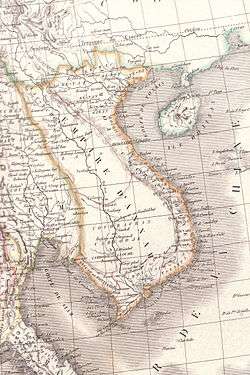 Vietnam in 1829 under the Nguyễn dynasty | ||||||||||||||
| Capital | Huế | |||||||||||||
| Languages | Vietnamese, French (after 1887) | |||||||||||||
| Religion | Neo-Confucianism, Buddhism, Catholicism | |||||||||||||
| Government | Monarchy | |||||||||||||
| Emperor | ||||||||||||||
| • | 1802–1820 | Gia Long (first) | ||||||||||||
| • | 1926–1945 | Bảo Đại (last) | ||||||||||||
| History | ||||||||||||||
| • | Coronation of Gia Long | 1 June 1802 | ||||||||||||
| • | French invasion | 1 September 1858 | ||||||||||||
| • | Japanese invasion | 22 September 1940 | ||||||||||||
| • | Abdication of Bảo Đại | 30 August 1945 | ||||||||||||
| Currency | Văn (Sapèque), Tiền | |||||||||||||
| ||||||||||||||
| Today part of | | |||||||||||||
The Nguyễn dynasty (Vietnamese: Nhà Nguyễn; Hán-Nôm: 阮朝, Nguyễn triều) was the last ruling family of Vietnam.[1] Their rule lasted a total of 143 years. It began in 1802 when Emperor Gia Long ascended the throne after defeating the Tây Sơn dynasty and ended in 1945 when Bảo Đại abdicated the throne and transferred power to the Democratic Republic of Vietnam. During the reign of Emperor Gia Long, the nation officially became known as Việt Nam (越南), but from the reign of emperor Minh Mạng on, the nation was renamed Đại Nam (大南, literally "Great South"). Their rule was marked by the increasing influence of French colonialism; the nation was eventually partitioned into three, Cochinchina became a French colony while Annam and Tonkin became protectorates which were independent in name only.
Origins
.jpg)
The Nguyễn family had been one of the major families in Vietnamese history, dating back to the days of the Hero–Emperor Lê Lợi. Due to a civil war and the weakness of the Later Lê dynasty, the Nguyễn and the Trịnh (another of the major families) joined together in opposition to the Mạc. Nguyễn Kim, the leader of this alliance, was assassinated in 1545 by a servant of the Mạc. Kim's son-in-law Trịnh Kiểm, killed the eldest son of Nguyễn Kim and take over the alliance. In 1558, Nguyễn Hoàng, the second son of Nguyễn Kim was given lordship over the southern, newly conquered provinces of middle and the South of Vietnam. He ruled from the city of Huế for the rest of his life and established the dominion of the Nguyễn lords in the southern part of the country. While the Nguyễn lords, like the Trịnh, paid tribute to the Lê Emperor, the reality was they ruled, not the king. Nguyễn Hòang and his successors continually expanded their territory by making Kampuchea as protectorate, and by invading Laos, Champa and many small countries in the area. The Nguyễn lords styled themselves as "lord" (Chúa in Vietnamese).
Birth of the dynasty
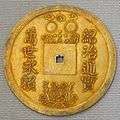

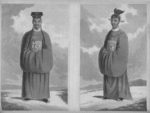
.jpg)
It was Nguyễn Phúc Nguyên (or Lord Sãi), Nguyễn Hoàng's son, who started the Nguyễn Phúc family name. 200 years later, Nguyễn Phúc Khoát was the first ruler of the line who styled himself King (Vương in Vietnamese), as the Trịnh lords began to do so in the North.
Nguyễn Phúc Ánh finally united Vietnam for the second time in 300 years. He started a dynasty and styled himself Emperor (Viet: Hoàng Đế) Gia Long. After Gia Long, other rulers of the dynasty would soon run into problems with Catholic missionaries and, subsequently, the involvement of Europeans in Indochina. The Qing Jiaqing Emperor of China refused the Vietnamese ruler Gia Long's request to change his country's name to Nam Việt, instead the Jiaqing Emperor changed the name instead to Việt Nam.[2]
His son Minh Mạng was then faced with the Lê Văn Khôi revolt, when native Christians and their European clergy tried to overthrow him and install a grandson of Gia Long who had converted to Roman Catholicism. This was only the start, as frequent revolts were launched by the missionaries in an attempt to Catholicize the throne and the country. Conversely[3] Minh Mạng is also noted for the creation of public lands as part of his reforms.[4]
Minh Mang enacted the final conquest of the Champa Kingdom after the centuries long Cham–Vietnamese wars. The Cham Muslim leader Katip Suma was educated in Kelantan and came back to Champa to declare a Jihad against the Vietnamese after Emperor Minh Mang's annexation of Champa.[5][6][7][8] The Vietnamese coercively fed lizard and pig meat to Cham Muslims and cow meat to Cham Hindus against their will to punish them and assimilate them to Vietnamese culture.[9]
Minh Mang sinicized ethnic minorities such as Cambodians, claimed the legacy of Confucianism and China's Han dynasty for Vietnam, and used the term Han people 漢人 (Hán nhân) to refer to the Vietnamese.[10][11] Minh Mang declared that "We must hope that their barbarian habits will be subconsciously dissipated, and that they will daily become more infected by Han [Sino-Vietnamese] customs."[12] These policies were directed at the Khmer and hill tribes.[13] The Nguyen lord Nguyen Phuc Chu had referred to Vietnamese as "Han people" in 1712 when differentiating between Vietnamese and Chams.[14] The Nguyen Lords established đồn điền after 1790. It was said "Hán di hữu hạn" 漢夷有限 ("the Vietnamese and the barbarians must have clear borders") by the Gia Long Emperor (Nguyễn Phúc Ánh) when differentiating between Khmer and Vietnamese.[15] Minh Mang implemented an acculturation integration policy directed at minority non-Vietnamese peoples.[16] Thanh nhân 清人 or Đường nhân 唐人 were used to refer to ethnic Chinese by the Vietnamese while Vietnamese called themselves as Hán dân 漢民 and Hán nhân 漢人 in Vietnam during the 1800s under Nguyễn rule.[17]
"Trung Quốc" 中國 was used as a name for Vietnam by Emperor Gia Long in 1805.[18]
Due to its dominance during the 19th century Vietnam regards Cambodia and Laos as vassal tributary states.[19]
The Nguyen dynasty implemented and spread Chinese style clothing.[20][21][22][23][24][25] Trousers have been adopted by White H'mong.[26] The trousers replaced the traditional skirts of the females of the White Hmong.[27] The tunics and trouser clothing of the Han Chinese on the Ming tradition was worn by the Vietnamese. The Ao Dai was created when tucks which were close fitting and compact were added in the 1920s to this Chinese style.[28] Trousers and tunics on the Chinese pattern in 1774 were ordered by the Vo Vuong Emperor to replace the sarong type Vietnamese clothing.[29] The Chinese clothing in the form of trousers and tunic were mandated by the Vietnamese Nguyen government. It was up to the 1920s in Vietnam's north area in isolated hamlets wear skirts were worn.[30] The Chinese Ming dynasty, Tang dynasty, and Han dynasty clothing was ordered to be adopted by Vietnamese military and bureaucrats by the Nguyen Lord Nguyễn Phúc Khoát (Nguyen The Tong).[31]
In 1841 a rant on how Confucian the Vietnamese were compared to the Qing "On Distinguishing Barbarians" was written in response to the Qing using the sign "Vietnamese Barbarians' Hostel" 越夷會館 for the Nguyen dynasty diplomat and ethnic Han Chinese Lý Văn Phức 李文馥.[2][32] It argued that the Qing did not subscribe to all neo-Confucianist texts from the Ming and Song which were learned by Vietnamese.[33] A single civilization which was identical was regarded to be shared by Vietnam and the Qing by the Vietnamese, who viewed themselves as having an Emperor and their own country as a "Middle Kingdom" with the essential argument that Vietnam "are Chinese, not barbarians" in his rant over the barbarian label in 1841.[34] Highland tribes and other non-Vietnamese ethnicities living near or within Vietnam were referred to as "barbarian" by the Vietnamese Imperial court, anything was barbarian if it was not "Chinese" in the eyes of the Vietnamese who had copied Chinese culture and governmental system and this was illustrated by the hostel incident.[35] "Hostel for the An Nam Barbarians" was written on the hostel in Fujian when Ly Van Phuc came to China to conduct diplomacy for the Nguyen.[36] In the essay he mentions the distinction between Yi and Hua and mentions Zhao Tuio, Wen, Shun and Taibo.[37][38] Professors Kelley and Woodside wrote on Vietnam's Confucianism.[39]
Emperors Minh Mạng, Thiệu Trị and Tự Đức, were opposed to French involvement in the country and tried to reduce the growing Catholic community in Vietnam at that time. The imprisonment of missionaries who had illegally entered the country was the primary pretext for the French to invade and occupy Indochina. Much like what had occurred in Qing China, there were also numerous incidents involving other (European) nations during the 19th century.
The last Nguyễn Emperor to rule with complete independence was Tự Đức. After his death, there was a succession crisis as the regent Tôn Thất Thuyết orchestrated the murders of three emperors in a year. This allowed the French to take direct control of the country and eventually gain complete control of the monarchy. All emperors since Đồng Khánh were chosen by the French and had only a symbolic position.
French protectorate
Napoleon III took the first steps to establishing a French colonial influence in Indochina. He approved the launching of a naval expedition in 1858 to punish the Vietnamese for their mistreatment of European Catholic missionaries and force the court to accept a French presence in the country. An important factor in his decision was the belief that France risked becoming a second-rate power by not expanding its influence in East Asia. Also, the idea that France had a civilizing mission was spreading. This eventually led to a full-out invasion in 1861.
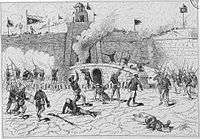

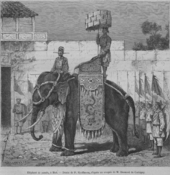
By 1862 the war was over and Vietnam conceded three provinces in the south, called by the French Cochinchina, opened three ports to French trade, allowed free passage of French warships to Kampuchea (which led to a French protectorate over Kampuchea in 1863), allowed freedom of action for French missionaries, and gave France a large indemnity for the cost of the war. France did not however intervene in the Christian-supported Vietnamese rebellion in Bắc Bộ, despite the urging of missionaries, or in the subsequent slaughter of thousands of Christians after the rebellion, suggesting that although persecution of Christians was the prompt for the intervention, military and political reasons ultimately drove colonialism in Vietnam.
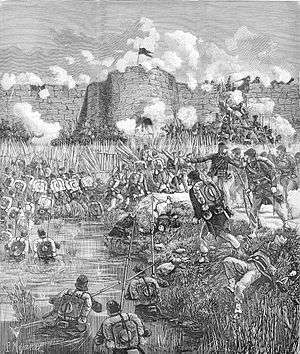
France completely conquered in 1885 the rest of Vietnam. They also promoted the further occupation and development of the Mekong Delta region by the Vietnamese. The Nguyễn Dynasty nominally ruled the French protectorates of Annam and Tonkin, which were, like Cochinchina, constituent territories of French Indochina. France added new ingredients to the cultural stew of Vietnam. The French added Catholicism and a writing system based upon Latin letters (see Vietnamese alphabet). The spelling used in this transliteration of Vietnamese surprisingly was Portuguese because the French relied upon a dictionary compiled earlier by a Portuguese cleric.
World War I
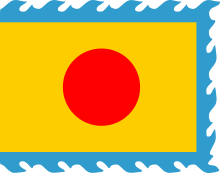
While seeking to maximize the use of Indochina's natural resources and manpower to fight World War I, France cracked down on all patriotic mass movements in Vietnam. Indochina, mainly Vietnam, had to provide France with 70,000 soldiers and 70,000 workers, who were forcibly drafted from the villages to serve on the French battlefront. Vietnam also contributed 184 million piasters in the form of loans and 336,000 tons of food.
These burdens proved all the heavier as agriculture was hard hit by natural disasters from 1914 to 1917.
.svg.png)
Lacking a unified nationwide organization, the Vietnamese national movement, though still vigorous, failed to take advantage of the difficulties France was experiencing as a result of war to stage any significant uprisings. In May 1916, the sixteen-year-old emperor, Duy Tân, escaped from his palace in order to take part in an uprising of Vietnamese troops. The French were informed of the plan and the leaders arrested and executed. Duy Tân was deposed and exiled to Réunion Island in the Indian Ocean.

World War II
Nationalist sentiments intensified in Vietnam, especially during and after the First World War, but all the uprisings and tentative efforts failed to obtain any concessions from the French overseers. The Russian Revolution which occurred at this time had a tremendous impact on shaping 20th century Vietnamese history.
The sequels to the Second World War: for Vietnam, the explosion of World War II on 1 September 1939 was an event as decisive as the French taking of Đà Nẵng in 1858. The Axis power of Japan invaded Vietnam on 22 September 1940, attempting to construct military bases to strike against the Allies in Southeast Asia.

.svg.png)
In 1941–1945, a communist resistance movement called the Viet Minh developed under the leadership of Ho Chi Minh. From 1944 to 1945 there was a famine in northern Vietnam in which over one million people starved to death. In March 1945, realizing the allied victory was inevitable, the Japanese overthrew the French authorities in Vietnam, imprisoned their civil servants and proclaimed Vietnam "independent" under Japanese "protection" with Bảo Đại as emperor.
Collapse of the dynasty
Japan surrendered on 15 August, triggering a revolt by the Vietminh. After receiving a "request" for his resignation, Bảo Đại abdicated on 30 August and handed power over to the Vietminh. Bảo Đại was named "supreme counsellor" to the new government. Bảo Đại left shortly afterward since he did not agree with the policies of the Vietminh and went into exile in Hong Kong. Following the return of the French in October, the French-Indochina War (1946–54) was fought between France and the Vietminh.
Succession and heads of dynasty
In 1948, the French persuaded Bảo Đại to return as "Chief of State" (Quốc Trưởng) of the "State of Vietnam" (Quốc Gia Việt Nam) set up by France in areas over which it had regained control, while a bloody war with the Viet Minh under Ho Chi Minh continued. Bảo Đại spent much of his time during that conflict enjoying a good life either at his luxurious home in Đà Lạt (in the Vietnamese Highlands) or in Paris, France. This came to end with the French defeat at Điện Biên Phủ in 1954.
The French negotiated with the U.S. to divide Vietnam. It was divided into North Vietnam going to the Viet Minh and South Vietnam going to a new government. Bảo Đại's prime minister, Ngô Đình Diệm, overthrew him in a 1955 referendum that, by most accounts, was flagrantly rigged. Not only did an implausible 98 percent of voters support Diem's proposal for a republic, but the number of votes for a republic far exceeded the number of registered voters. Diem then assumed the position of President of the Republic of Vietnam (Việt Nam Cộng Hòa), once more ending Bảo Đại's involvement in Vietnamese affairs – this time permanently.
Bảo Đại went into exile in France, where he died in 1997 and was buried in Cimetière de Passy. Crown Prince Bảo Long succeeded on the death of his father Emperor Bảo Đại as Head of the Imperial House of Vietnam, 31 July 1997. He was in turn succeeded by his brother Bảo Thắng on 28 July 2007.
List of Nguyễn emperors
The following list is the emperors' era names, which have meaning in Chinese and Vietnamese. For example, the first ruler's era name, Gia Long, is the combination of the old names for Saigon (Gia Định) and Hanoi (Thăng Long) to show the new unity of the country; the fourth, Tự Đức, means "Inheritance of Virtues"; the ninth, Đồng Khánh, means "Collective Celebration".
| Temple name | Posthumous name | Personal name | Lineage | Reign | Regnal name | Royal Tomb | Events |
|---|---|---|---|---|---|---|---|
| 世祖 Thế Tổ | 開天弘道立紀垂統神文聖武俊德隆功至仁大孝高皇帝 Khai Thiên Hoằng Đạo Lập Kỷ Thùy Thống Thần Văn Thánh Vũ Tuấn Đức Long Công Chí Nhân Đại Hiếu Cao Hoàng Đế |
阮福暎 Nguyễn Phúc Ánh |
Nguyễn lord | 1802–20 | 嘉隆 1802–20 Gia Long |
千壽陵 Thiên Thọ lăng | unified the whole country, founder of Vietnam's last dynasty, named the country as Vietnam for the first time |
| 聖祖 Thánh Tổ | 體天昌運至孝淳德文武明斷創述大成厚宅豐功仁皇帝 Thể Thiên Xương Vận Chí Hiếu Thuần Đức Văn Vũ Minh Đoán Sáng Thuật Đại Thành Hậu Trạch Phong Công Nhân Hoàng Đế |
阮福晈 Nguyễn Phúc Kiểu |
son | 1820–41 | 明命 1820–41 Minh Mạng |
孝陵 Hiếu Lăng | annexed the remaining of the Champa kingdom, renamed the country Đại Nam, suppress religion |
| 憲祖 Hiến Tổ | 紹天隆運至善淳孝寬明睿斷文治武功聖哲章皇帝 Thiệu Thiên Long Vận Chí Thiện Thuần Hiếu Khoan Minh Duệ Đoán Văn Trị Vũ Công Thánh Triết Chượng Chương Hoàng Đế |
阮福暶 Nguyễn Phúc Tuyền |
son | 1841–47 | 紹治 1841–47 Thiệu Trị |
昌陵 Xương Lăng | |
| 翼宗 Dực Tông | 世天亨運至誠達孝體健敦仁謙恭明略睿文英皇帝 Thể Thiên Hanh Vận Chí Thành Đạt Hiếu Thể Kiện Đôn Nhân Khiêm Cung Minh Lược Duệ Văn Anh Hoàng Đế |
阮福時 Nguyễn Phúc Thì |
son | 1847–83 | 嗣德 1847–83 Tự Đức |
謙陵 Khiêm Lăng | faced the French invasion and cede Cochinchina to France. |
| 恭宗 Cung Tông | 惠皇帝 Huệ Hoàng Đế |
— — |
nephew | 1883 | 育德 1883 Dục Đức |
安陵 An Lăng | |
| – | — | 阮福昇 Nguyễn Phúc Thăng |
uncle (son of Thiệu Trị) | 1883 | 協和 1883 Hiệp Hòa | Three-Day Emperor | — |
| 簡宗 Giản Tông | 紹德志孝淵睿毅皇帝 Thiệu Đức Chí Hiếu Uyên Duệ Nghị Hoàng Đế |
阮福昊 Nguyễn Phúc Hạo |
nephew (son of older brother of Hiệp Hòa) | 1883–84 | 建福 1883–84 Kiến Phúc |
陪陵 Bồi Lăng | Four-Month Emperor, ruled during a period of turmoil |
| – | — | 阮福明 Nguyễn Phúc Minh |
older brother | 1884–85 | 咸宜 1884–85 Hàm Nghi |
Thonac Cemetery, France | was dethroned after 1 year because stratagem piles the West, but continued the rebellion until was captured in 1888 and forced to exile to Algeria |
| 景宗 Cảnh Tông | 弘烈統哲敏惠純皇帝 Hoằng Liệt Thống Thiết Mẫn Huệ Thuần Hoàng Đế |
阮福昪 Nguyễn Phúc Biện |
older brother | 1885–89 | 同慶 1885–89 Đồng Khánh |
思陵 Tư Lăng | pro-Western |
| – | — | 阮福昭 Nguyễn Phúc Chiêu |
cousin (son of Dục Đức) | 1889–1907 | 成泰 1889–1907 Thành Thái |
安陵 An Lăng | |
| – | — | 阮福晃 Nguyễn Phúc Hoảng |
son | 1907–16 | 維新 1907–16 Duy Tân |
安陵 An Lăng | |
| 弘宗 Hoằng Tông | 嗣代嘉運聖明神智仁孝誠敬貽謨承烈宣皇帝 Tự Đại Gia Vận Thánh Minh Thần Trí Nhân Hiếu Thành Kính Di Mô Thừa Liệt Tuyên Hoàng Đế |
阮福昶 Nguyễn Phúc Tuấn |
cousin (son of Đồng Khánh) | 1916–25 | 啟定 1916–25 Khải Định |
應陵 Ứng Lăng | Closely collaborated with the French regime and was effectively a puppet political figurehead for French colonial rulers. He was very unpopular with the Vietnamese people. The nationalist leader Phan Châu Trinh accused him of selling out his country to the French and living in imperial luxury while the people were exploited by France. |
| – | — | 阮福晪 Nguyễn Phúc Thiển² |
son | 1926–45 | 保大 1926–45 Bảo Đại |
Cimetière de Passy, France | Created the Empire of Vietnam under Japanese occupation during World War II, then abdicated and transferred power to the Viet Minh in 1945, ending the Vietnamese monarchy. Later removed as head of state of the State of Vietnam, changing it into a republic with President Ngo Dinh Diem as head of state. Bao Dai remained unpopular amongst the Vietnamese populace as he was considered a political puppet for the French colonialist regime, for lacking any form of political power, for his cooperation with the French and for his pro-French ideals. |
- Following the death of Emperor Tự Đức, and according to his will, this Emperor ascended to the throne on 19 July 1883. However, he was dethroned and imprisoned three days later, after being accused of deleting one paragraph from Tự Đức's will. He had no time to announce his dynastic title (era name); hence his was named after his residential palace as Dục Đức.
- Crown Prince Bảo Long succeeded on the death of his father, Emperor Bảo Đại, as Head of the Imperial House of Vietnam on 31 July 1997.
- Prince Bảo Thắng following the death of his brother, Crown Prince Bảo Long, succeeded as head of the Nguyễn dynasty on 28 July 2007.
Lineage
| 1 Gia Long 1802–1819 | |||||||||||||
| 2 Minh Mạng 1820–1840 | |||||||||||||
| 3 Thiệu Trị 1841–1847 | |||||||||||||
| 4 Tự Đức 1847–1883 | Thoại Thái Vương | Kiên Thái Vương | 6 Hiệp Hoà 1883 | ||||||||||
| 5 Dục Đức 1883 | 9 Đồng Khánh 1885–1889 | 8 Hàm Nghi 1884–1885 | 7 Kiến Phúc 1883–1884 | ||||||||||
| 10 Thành Thái 1889–1907 | 12 Khải Định 1916–1925 | ||||||||||||
| 11 Duy Tân 1907–1916 | 13 Bảo Đại 1926–1945 | ||||||||||||
Note:
- Years in the table are their reigning years.
- See also: Family tree of Nguyễn Lords
| — Royal house — Nguyễn dynasty Founding year: 1802 Deposition: 1945 | ||
| Preceded by Tây Sơn dynasty |
Dynasty of Vietnam 1 June 1802 – 30 August 1945 |
Vacant |
See also
- French Indochina
- List of Vietnamese dynasties
- Vietnam during World War I
- Nguyễn Trường Tộ – served Emperor Tự Đức
Notes
- ↑ Member of the Imperial Chinese tributary system (1803–1885)
References
- ↑ Li, Tana; Reid, Anthony (1993). Southern Vietnam under the Nguyễn. Economic History of Southeast Asia Project. Australian National University. ISBN 981-3016-69-8.
- 1 2 Alexander Woodside (1971). Vietnam and the Chinese Model: A Comparative Study of Vietnamese and Chinese Government in the First Half of the Nineteenth Century. Harvard Univ Asia Center. pp. 120–. ISBN 978-0-674-93721-5.
- ↑ Jacob Ramsay -Mandarins and Martyrs: The Church and the Nguyễn Dynasty in Early ... 2008 "This book is about the rise of anti-Catholic violence in early nineteenth-century Vietnam under the Nguyễn Dynasty, and the profound social and political changes it created in the decades preceding French colonialism."
- ↑ Choi Byung Wook Southern Vietnam Under the Reign of Minh Mạng (1820–1841): 2004 Page 161 "These authors identify the creation of public land as the most important result of land measurement, and they judge that project to have been a significant achievement of the Nguyen dynasty, writing: "Minh Mang clearly did not want southern ..."
- ↑ Jean-François Hubert (8 May 2012). The Art of Champa. Parkstone International. pp. 25–. ISBN 978-1-78042-964-9.
- ↑ "The Raja Praong Ritual: A Memory of the Sea in Cham- Malay Relations". Cham Unesco. Archived from the original on 6 February 2015. Retrieved 25 June 2015.
- ↑ (Extracted from Truong Van Mon, "The Raja Praong Ritual: a Memory of the sea in Cham- Malay Relations”, in Memory And Knowledge Of The Sea In South Asia, Institute of Ocean and Earth Sciences, University of Malaya, Monograph Series 3, pp, 97–111. International Seminar on Martime Culture and Geopolitics & Workshop on Bajau Laut Music and Dance”, Institute of Ocean and Earth Sciences and the Faculty of Arts and Social Sciences, University of Malaya, 23-24/2008)
- ↑ Dharma, Po. "The Uprisings of Katip Sumat and Ja Thak Wa (1833–1835)". Cham Today. Retrieved 25 June 2015.
- ↑ Choi Byung Wook (2004). Southern Vietnam Under the Reign of Minh Mạng (1820–1841): Central Policies and Local Response. SEAP Publications. pp. 141–. ISBN 978-0-87727-138-3.
- ↑ Norman G. Owen (2005). The Emergence of Modern Southeast Asia: A New History. University of Hawaii Press. pp. 115–. ISBN 978-0-8248-2890-5.
- ↑ Zottoli, Brian A. (2011). Reconceptualizing Southern Vietnamese Hi story from the 15th to 18th Centuries: Competition along the Coasts from Guangdong to Cambod (PDF) (A dissertation submitted in partial fulfillment of the requirements for the degree of Doctor of Philosophy (History) in The University of Michigan). p. 14. Archived from the original on
|archive-url=requires|archive-date=(help). - ↑ A. Dirk Moses (1 January 2008). Empire, Colony, Genocide: Conquest, Occupation, and Subaltern Resistance in World History. Berghahn Books. pp. 209–. ISBN 978-1-84545-452-4. Archived from the original on 2008.
- ↑ Randall Peerenboom; Carole J. Petersen; Albert H.Y. Chen (27 September 2006). Human Rights in Asia: A Comparative Legal Study of Twelve Asian Jurisdictions, France and the USA. Routledge. pp. 474–. ISBN 978-1-134-23881-1.
- ↑ https://web.archive.org/web/20040617071243/http://kyotoreview.cseas.kyoto-u.ac.jp/issue/issue4/article_353.html
- ↑ Choi Byung Wook (2004). Southern Vietnam Under the Reign of Minh Mạng (1820–1841): Central Policies and Local Response. SEAP Publications. pp. 34–. ISBN 978-0-87727-138-3.
- ↑ Choi Byung Wook (2004). Southern Vietnam Under the Reign of Minh Mạng (1820–1841): Central Policies and Local Response. SEAP Publications. pp. 136–. ISBN 978-0-87727-138-3.
- ↑ Choi Byung Wook (2004). Southern Vietnam Under the Reign of Minh Mạng (1820–1841): Central Policies and Local Response. SEAP Publications. pp. 137–. ISBN 978-0-87727-138-3.
- ↑ Alexander Woodside (1971). Vietnam and the Chinese Model: A Comparative Study of Vietnamese and Chinese Government in the First Half of the Nineteenth Century. Harvard Univ Asia Center. pp. 18–. ISBN 978-0-674-93721-5.
- ↑ "Laos and Cambodia". Country Studies. U.S. Library of Congress.
- ↑ Alexander Woodside (1971). Vietnam and the Chinese Model: A Comparative Study of Vietnamese and Chinese Government in the First Half of the Nineteenth Century. Harvard Univ Asia Center. pp. 134–. ISBN 978-0-674-93721-5.
- ↑ Globalization: A View by Vietnamese Consumers Through Wedding Windows. ProQuest. 2008. pp. 34–. ISBN 978-0-549-68091-8.
- ↑ http://angelasancartier.net/ao-dai-vietnams-national-dress
- ↑ http://beyondvictoriana.com/2010/03/14/beyond-victoriana-18-transcultural-tradition-of-the-vietnamese-ao-dai/
- ↑ http://fashion-history.lovetoknow.com/clothing-types-styles/ao-dai
- ↑ http://www.tor.com/2010/10/20/ao-dai-and-i-steampunk-essay/
- ↑ Vietnam. Michelin Travel Publications. 2002. p. 200.
- ↑ Gary Yia Lee; Nicholas Tapp (16 September 2010). Culture and Customs of the Hmong. ABC-CLIO. pp. 138–. ISBN 978-0-313-34527-2.
- ↑ Anthony Reid (2 June 2015). A History of Southeast Asia: Critical Crossroads. John Wiley & Sons. pp. 285–. ISBN 978-0-631-17961-0.
- ↑ Anthony Reid (9 May 1990). Southeast Asia in the Age of Commerce, 1450–1680: The Lands Below the Winds. Yale University Press. pp. 90–. ISBN 978-0-300-04750-9.
- ↑ A. Terry Rambo (2005). Searching for Vietnam: Selected Writings on Vietnamese Culture and Society. Kyoto University Press. p. 64. ISBN 978-1-920901-05-9.
- ↑ Jayne Werner; John K. Whitmore; George Dutton (21 August 2012). Sources of Vietnamese Tradition. Columbia University Press. pp. 295–. ISBN 978-0-231-51110-0.
- ↑ https://read01.com/PRoyz7.html http://tw.aboluowang.com/2014/0525/399945.html https://kknews.cc/history/mgllaz.html http://www.wanhuajing.com/d540264 http://dajia.qq.com/blog/264933028072213.html http://www.360doc.com/content/16/0615/11/33461260_567937012.shtml http://bbs.creaders.net/history/bbsviewer.php?trd_id=972646&language=big5 http://k.sina.cn/article_1737243281_678c3a91001002ag2.html?vt=4 http://www.lwxww.cn/system/2014/10/29/010483307.shtml
- ↑ John Gillespie; Albert H.Y. Chen (30 July 2010). Legal Reforms in China and Vietnam: A Comparison of Asian Communist Regimes. Taylor & Francis. pp. 6–. ISBN 978-0-203-85269-9.John Gillespie; Albert H.Y. Chen (13 September 2010). Legal Reforms in China and Vietnam: A Comparison of Asian Communist Regimes. Routledge. pp. 6–. ISBN 978-1-136-97843-2.John Gillespie; Albert H.Y. Chen (13 September 2010). Legal Reforms in China and Vietnam: A Comparison of Asian Communist Regimes. Routledge. pp. 6–. ISBN 978-1-136-97842-5.
- ↑ Charles Holcombe (January 2001). The Genesis of East Asia: 221 B.C. – A.D. 907. University of Hawaii Press. pp. 41–. ISBN 978-0-8248-2465-5.
- ↑ Pamela D. McElwee (2003). 'Lost worlds' or 'lost causes'?: biodiversity conservation, forest management, and rural life in Vietnam. Yale University. p. 67.Pamela D. McElwee (2003). 'Lost worlds' or 'lost causes'?: biodiversity conservation, forest management, and rural life in Vietnam. Yale University. p. 67.
- ↑ Journal of Vietnamese Studies. University of California Press. 2006. p. 317.
- ↑ Journal of Vietnamese Studies. University of California Press. 2006. p. 325.
- ↑ Kelley, L. (2006). "Confucianism" in Vietnam: A State of the Field Essay. Journal of Vietnamese Studies, 1(1–2), 325. doi:1. Retrieved from http://www.jstor.org/stable/10.1525/vs.2006.1.1-2.314?seq=12 doi:1 https://www.researchgate.net/publication/249988625_Confucianism_in_Vietnam_A_State_of_the_Field_Essay http://vs.ucpress.edu/content/1/1-2/314 http://khoavanhoc.edu.vn/attachments/381_Liam%20Kelley_%20Confucianism%20in%20Vietnam,%202006.pdf
- ↑ https://cindyanguyen.wordpress.com/2016/03/09/confucianism_vietnam/
External links
| Wikimedia Commons has media related to Nguyễn Dynasty. |
